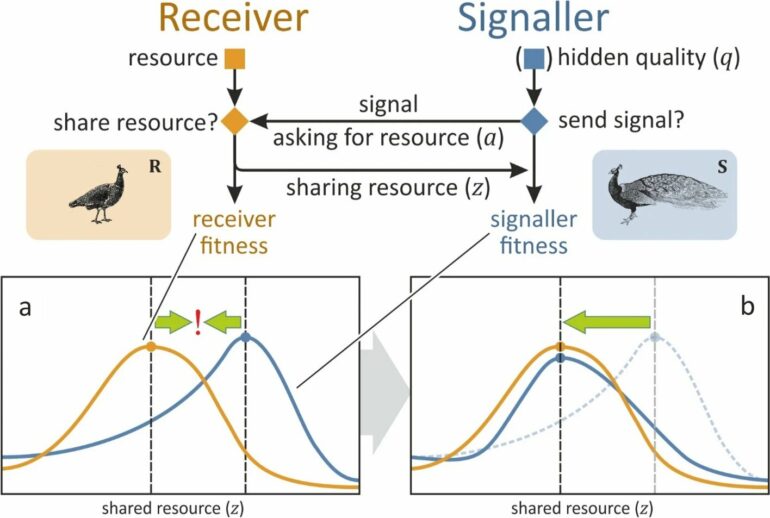Sexual selection provides an answer to the existence of lavishly ornate signals in animals, but not to the question of why such signals are attractive—for example, why do females prefer the extravagant plumage of peacocks? As part of an international team, researchers at Eötvös Loránd University (ELTE) have shown that the reason is not the presumed wasteful cost of ornaments, as honest signals need not have to be costly at all as long as cheaters would have to pay to fake them.
Researchers have developed a general formula to calculate honest equilibrium in any model, independent of the cost of these ornaments. Their results have been published in BMC Biology.
The diversity of signals used in the animal world has filled people with curiosity and wonder since the dawn of times. Why does the peacock have a decorative tail, what is the purpose of antlers on deer, why are butterflies so colorful? At first glance, these striking decorations seem to have little use.
Attractive ornaments, selfish genes
The father of modern evolutionary theory, Charles Darwin, came up with a revolutionary new theory: peacocks have a decorative tail because females prefer to mate with decorated males. Darwin called this “sexual selection.” Since then, it has been demonstrated in numerous animal species that females prefer certain traits in males. However, Darwin did not answer a very important question:
Why do females prefer overly decorated males?
The question was sidelined for a while. Meanwhile, the gene-centered approach gained prominence, which became globally known with Richard Dawkins’ book “The Selfish Gene.” The essence is that individuals represent the interests of their genes, not themselves. However, this carries the problem of cheating.
If an individual can gain an advantage for its genes by deceiving another individual (e.g., a male deceiving a female), then why wouldn’t it do so? Dawkins described communication interactions as a duel between “manipulators” and “mind readers” and came to the not too optimistic conclusion that most signals are manipulative, meaning they are not honest. Therefore, hidden traits of the animal, such as their true quality, cannot be inferred from the signal.
The problem of honesty
More than 100 years after Darwin, Amotz Zahavi elegantly linked the two problems. According to Zahavi, females prefer males with fancy feathers because these decorations are extravagantly expensive, and only capable individuals can afford the cost.
It is not worth it for an individual with poor genes or poor conditions to maintain the expensive signal. Zahavi called this the Handicap Principle, and he believed that the cost of signals maintains their honesty. It is not that these traits have no benefit, but rather that they are disadvantageous for survival (expensive), but advantageous for reproduction (as it is also about Darwinian sexual selection).
Zahavi generously claimed that all signals found in nature work according to the Handicap Principle, that is, they are honest and costly. Biologists have also started to measure the cost of signals used in evolutionary equilibrium. However, they quickly concluded that in most cases, there is no visible extravagant cost. At the same time, several theoretical models have shown that an honest signal does not need to be expensive in evolutionary balance. However, these models describe very specific situations, so it was not clear how much criticism could be drawn from them.
The science of honesty
Researchers from BME, ELTE, ÖK Institute of Evolutionary Biology, and the Konrad Lorenz Institute have published a study in BMC Biology that provides a general formula that can be used to calculate the possible states of honest equilibrium in any situation. The general solution reveals that honesty does not require signal costs to be paid in equilibrium.
With this, the researchers directly refuted the more than 50-year-old Handicap Principle. According to the study, there can be an honest equilibrium where the signal is honest and cost-free, or even where the honest signal brings additional benefits to the user (negative cost). Therefore, the cost is not borne by the honest individual—it is the cost of cheating that really matters.
For a peacock with good genes, his spectacular plumage may be cheap (since he can produce it effectively) and yet his signal will still be honest if the same decoration is costly to produce for cheaters.
The cost of cheating is what counts for honesty
Let’s take another example from economics. A counterfeit banknote is not an honest signal. To make real money honest, the National Bank does not need to bear extra costs; instead, it is necessary to increase the potential cost of counterfeiting. The punishment must be greater than the profit from counterfeiting. It is beneficial for the National Bank to print cheaply, and if there is asymmetry against cheaters: for them, it is much more expensive.
It was already known from previous models that the cost of cheating matters for honesty. The significance of the recent study is that it presents this knowledge as a generally applicable formula. That is, honest equilibrium states and expected costs can now be calculated in any context, which is a very powerful tool in the hands of researchers.
With the help of the results, Darwin’s original question can be answered: why do females prefer extravagantly ornate males? Like everything shaped by Darwinian selection, honesty is also about efficiency, without assuming “wasteful” spending of males: honest individuals are not wasteful, but efficient.
More information:
Szabolcs Számadó et al, Honesty in signalling games is maintained by trade-offs rather than costs, BMC Biology (2023). DOI: 10.1186/s12915-022-01496-9
Provided by
Eötvös Loránd University
Citation:
Sexual selection: Why do females prefer ornate male signals? (2023, April 4)



